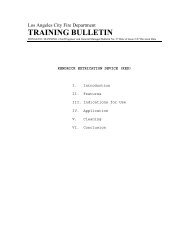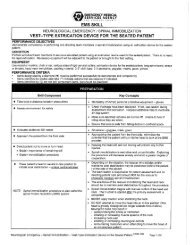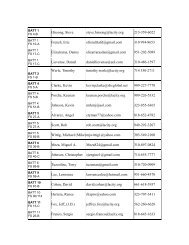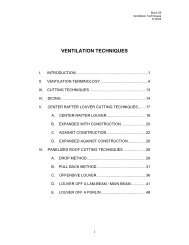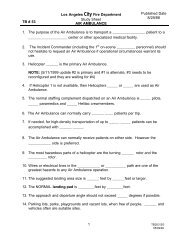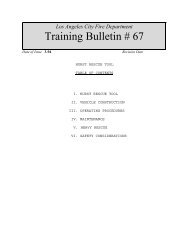SMOKE REMOVAL I. INTRODUCTION ... - LAFD Training
SMOKE REMOVAL I. INTRODUCTION ... - LAFD Training
SMOKE REMOVAL I. INTRODUCTION ... - LAFD Training
You also want an ePaper? Increase the reach of your titles
YUMPU automatically turns print PDFs into web optimized ePapers that Google loves.
educed.<br />
20<br />
Book 29<br />
Smoke Removal<br />
06/12/00<br />
• Smoke within the overhaul area can be substantially reduced depending on the<br />
degree of extinguishment within the overhaul area.<br />
• Similar to heat and smoke, concentrations of carbon monoxide and other toxic<br />
gases can be significantly reduced.<br />
Carbon Monoxide Guidelines<br />
Depending on the type of fire, concentrations of carbon monoxide within the range<br />
of 500 parts-per-million (ppm) to 1200 ppm are easily obtainable during overhaul<br />
operations.<br />
NOTE: For comparative purposes, the following guidelines are regarded as<br />
acceptable carbon monoxide concentration standards:<br />
• to 500 ppm of carbon monoxide can be inhaled for one hour without appreciable<br />
effects.<br />
• to 700 ppm of carbon monoxide inhaled for one hour will cause some<br />
appreciable effects.<br />
• to 1200 ppm of carbon monoxide inhaled for one hour is dangerous.<br />
• Concentrations of 4000 ppm of carbon monoxide and over are fatal in less than<br />
one hour.<br />
Measurements during actual overhaul operations have indicated that positive<br />
pressure can easily reduce carbon monoxide concentrations of 1000 ppm to<br />
approximately 130 ppm to 220 ppm.<br />
Overhaul Guidelines<br />
The effectiveness of using positive pressure during overhaul operations is<br />
determined by the overhaul area (size and overhaul materials) and the blowers that



